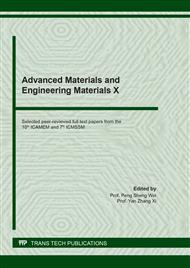p.161
p.167
p.174
p.181
p.188
p.196
p.202
p.207
p.213
The High-Temperature Tensile Test of Quartz Fiber Fabric- Reinforced Resin Composites
Abstract:
The tensile properties of quartz fiber fabric-reinforced resin composites at high temperature were studied. The effects of specimen type and dimension, temperature loading procedure, holding time and loading rate on the tensile properties of the composites at high temperatures were analyzed through series of comparative experiments, the tensile test parameters were determined. Chinese national standard for high-temperature tensile property testing of the composites was compiled based on the data collected. According to the established standard, the tensile testing at 500°C was carried out. Compared with the tensile properties at room temperature, the tensile strength and tensile modulus of the composite at high temperature decreases significantly, with the tensile strength decreasing by about 42.32% and the tensile modulus decreasing by about 24.18%. This is mainly due to the high temperature which causes part of the resin matrix to pyrolyze and detach from around the fiber, thus losing the integrity of the material. In addition, this national standard for high-temperature tensile properties has some general applicability to different types of fiber-reinforced resin composites.
Info:
Periodical:
Pages:
188-195
Citation:
Online since:
November 2021
Authors:
Price:
Сopyright:
© 2021 Trans Tech Publications Ltd. All Rights Reserved
Share:
Citation:


